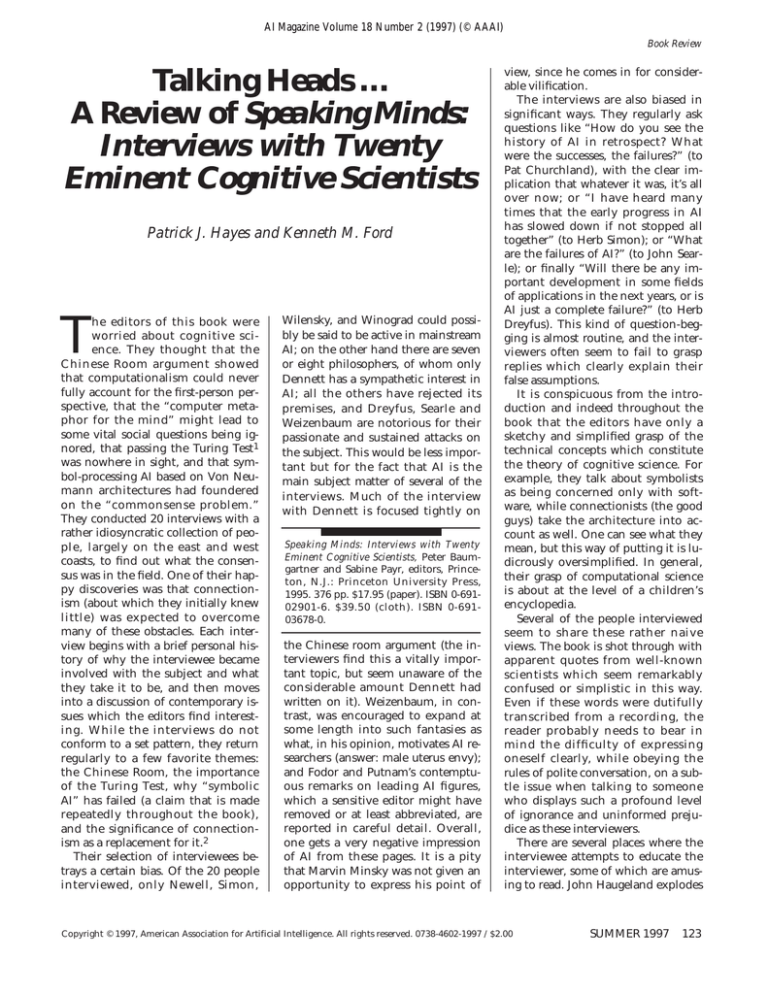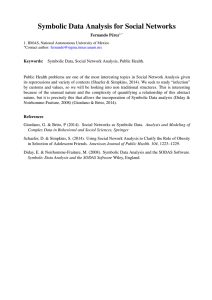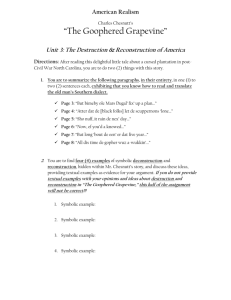
AI Magazine Volume 18 Number 2 (1997) (© AAAI)
Book Review
Talking Heads …
A Review of Speaking Minds:
Interviews with Twenty
Eminent Cognitive Scientists
Patrick J. Hayes and Kenneth M. Ford
T
he editors of this book were
worried about cognitive science. They thought that the
Chinese Room argument showed
that computationalism could never
fully account for the first-person perspective, that the “computer metaphor for the mind” might lead to
some vital social questions being ignored, that passing the Turing Test1
was nowhere in sight, and that symbol-processing AI based on Von Neumann architectures had foundered
on the “commonsense problem.”
They conducted 20 interviews with a
rather idiosyncratic collection of people, largely on the east and west
coasts, to find out what the consensus was in the field. One of their happy discoveries was that connectionism (about which they initially knew
little) was expected to overcome
many of these obstacles. Each interview begins with a brief personal history of why the interviewee became
involved with the subject and what
they take it to be, and then moves
into a discussion of contemporary issues which the editors find interesting. While the interviews do not
conform to a set pattern, they return
regularly to a few favorite themes:
the Chinese Room, the importance
of the Turing Test, why “symbolic
AI” has failed (a claim that is made
repeatedly throughout the book),
and the significance of connectionism as a replacement for it.2
Their selection of interviewees betrays a certain bias. Of the 20 people
interviewed, only Newell, Simon,
Wilensky, and Winograd could possibly be said to be active in mainstream
AI; on the other hand there are seven
or eight philosophers, of whom only
Dennett has a sympathetic interest in
AI; all the others have rejected its
premises, and Dreyfus, Searle and
Weizenbaum are notorious for their
passionate and sustained attacks on
the subject. This would be less important but for the fact that AI is the
main subject matter of several of the
interviews. Much of the interview
with Dennett is focused tightly on
Speaking Minds: Interviews with Twenty
Eminent Cognitive Scientists, Peter Baumgartner and Sabine Payr, editors, Princeton, N.J.: Princeton University Press,
1995. 376 pp. $17.95 (paper). ISBN 0-69102901-6. $39.50 (cloth). ISBN 0-69103678-0.
the Chinese room argument (the interviewers find this a vitally important topic, but seem unaware of the
considerable amount Dennett had
written on it). Weizenbaum, in contrast, was encouraged to expand at
some length into such fantasies as
what, in his opinion, motivates AI researchers (answer: male uterus envy);
and Fodor and Putnam’s contemptuous remarks on leading AI figures,
which a sensitive editor might have
removed or at least abbreviated, are
reported in careful detail. Overall,
one gets a very negative impression
of AI from these pages. It is a pity
that Marvin Minsky was not given an
opportunity to express his point of
view, since he comes in for considerable vilification.
The interviews are also biased in
significant ways. They regularly ask
questions like “How do you see the
history of AI in retrospect? What
were the successes, the failures?” (to
Pat Churchland), with the clear implication that whatever it was, it’s all
over now; or “I have heard many
times that the early progress in AI
has slowed down if not stopped all
together” (to Herb Simon); or “What
are the failures of AI?” (to John Searle); or finally “Will there be any important development in some fields
of applications in the next years, or is
AI just a complete failure?” (to Herb
Dreyfus). This kind of question-begging is almost routine, and the interviewers often seem to fail to grasp
replies which clearly explain their
false assumptions.
It is conspicuous from the introduction and indeed throughout the
book that the editors have only a
sketchy and simplified grasp of the
technical concepts which constitute
the theory of cognitive science. For
example, they talk about symbolists
as being concerned only with software, while connectionists (the good
guys) take the architecture into account as well. One can see what they
mean, but this way of putting it is ludicrously oversimplified. In general,
their grasp of computational science
is about at the level of a children’s
encyclopedia.
Several of the people interviewed
seem to share these rather naive
views. The book is shot through with
apparent quotes from well-known
scientists which seem remarkably
confused or simplistic in this way.
Even if these words were dutifully
transcribed from a recording, the
reader probably needs to bear in
mind the difficulty of expressing
oneself clearly, while obeying the
rules of polite conversation, on a subtle issue when talking to someone
who displays such a profound level
of ignorance and uninformed prejudice as these interviewers.
There are several places where the
interviewee attempts to educate the
interviewer, some of which are amusing to read. John Haugeland explodes
Copyright © 1997, American Association for Artificial Intelligence. All rights reserved. 0738-4602-1997 / $2.00
SUMMER 1997
123
Book Review
at the suggestion that when one is
considering a trained skill, symbolic
models are irrelevant because “the
brain just does it,” and attempts
valiantly to explain the concept of a
virtual machine and show why the
interviewer’s simplistic distinction
between hardware and software is too
elementary; and one can almost hear
the care in James McLelland’s voice
as he tries to dissect the interviewer’s
simplistic notion of “symbolic.” Unfortunately, these valiant efforts do
not seem to have resulted in the other interviews avoiding the same pitfalls. Sometimes the exchange consists of an incoherent, vague, or
ridiculous question (“Couldn’t one
argue that on the underlying level,
the microprocessor and the circuits
also form a pattern that is like the
brain?” or, one of our favorites: “The
symbol people invented LISP to support their point of view. Are connectionists working on a programming
language…?”) followed by a puzzled,
or politely noncommittal, reply; one
has the impression that the interviewee just didn’t think it worth the effort to attempt the required amount
of re-education. On other occasions,
however, the interviewees seem to
have decided to descend to the interviewer’s conversational level, allowing rules of polite discourse to override their usual intellectual care. The
result is confusing if one is seeking
for content, but can be insightful if
one is interested in seeing how some
famous thinkers’ minds run, since
they here express themselves in a
more casual way than their writings
usually display.
This book is most useful not as a
source of facts, but of opinions, attitudes, prejudices, hopes, and ambitions. The most interesting parts of
the interviews are often the initial
brief autobiographies in which people explain how they came to be
working in cognitive science. Pat
Churchland’s farming childhood accounts for her fascination with wetware; Newell’s account of the postWW2 intellectual climate is
fascinating, if brief, and complex
forces helped form the young
Weizenbaum’s views about binary
thinking and the evils of Western sci-
124
AI MAGAZINE
ence. Dreyfus tells us that he has
been interested in AI since 1957 as a
kind of distillation of, and scapegoat
for, a rationalist philosophical position which he rejects (although he
doesn’t tell us why). Dreyfus knew
from the start that AI was doomed, as
it represents Husserl’s archaic rationalism, long refuted by Heiddeger. He
is not making a judgment based on
evidence, but seeking arguments to
bolster his faith; his relentlessly misinformed and shrilly emotional attacks on AI make more sense when
seen against this background. Lakoff
spends three pages telling us the history of his intellectual development
and how it was at every stage somewhat ahead of Chomsky’s (who, regrettably, could not be interviewed.)
His interview is also notable for the
grandeur of its ambition, which at
times approaches the poetic intensity,
and indeed the poetic confusion, of
William Blake. Lakoff is convinced
that because humans think metaphorically, the human race will have
to rebuild its intellectual foundations, civilization will rewrite its laws
and constitutions, and our entire
view of reality will be transformed.
No doubt cognitive science can also
expect a good brushing-over. Searle
has been repeating the same arguments now for almost two decades
and is still convinced that his Chinese room argument is correct. He
shows a quite remarkable degree of
self-confidence, bordering indeed on
the delusional.
It is interesting that in some circles, most of them apparently orbiting Berkeley, the word “symbolic”
has become a kind of generalized
term of abuse, rather as “communist”
was in much of American politics in
the fifties and “liberal” is now. Its exact technical meaning seems adaptable from case to case, however. Lotfi
Zadeh feels that the use of fuzzy logic
will somehow escape the yoke of
symbol-hood; Herb Dr eyfus is
confident that biological plausibility
will enable connectionism to escape
the Husserlian rigidity of symbolic rationality; Terry Winograd explains
how conversations with Dreyfus led
him to Heiddeger, where he saw that
“symbolic” models lacked the neces-
sary social connectivity, while Haugeland (a former student of Dreyfus),
feels that good old-fashioned symbolic AI lacks the sheer computational
power needed to overcome the “commonsense problem.” Proponents of
the symbolic perspective might almost be encouraged by the lack of coherence in the various positions arrayed against them here.
Many of the views expressed are
quite predictable (Zadeh, for example, attributes all the problems of
cognitive science to its attachment to
binary truth-values), but some are
more surprising. Hilary Putnam was
one of the first philosophers to articulate some of the basic insights of
computer modeling in psychology
and made pioneering technical contributions to the subject (the DavisPutnam inference method is still
asymptotically as good as any), so the
vehemence with which he criticizes
the field and dismisses its achievements is striking. Like Jerry Fodor,
who also comes across from this interview as a virulent critic of AI, Putnam dismisses the actual subject matter of AI as unimportant engineering
details. Being unable to see anything
else, he concludes that there is nothing there but empty boasting. On the
other hand, the sociologist Aaron Cicourel carefully resists a barrage of
confused and leading questions
(“What do you think about the discipline of AI called ‘knowledge engineering’? Don’t you think their concept of ‘knowledge’ is totally
formalized?”) and gives a thoughtful
and well-informed analysis of the
likely role of AI technology in society.
Perhaps our experience has been unfortunate, but Cicourel seems to us to
be unusual among sociologists in his
clear grasp of these issues.
Several of those interviewed, especially the philosophers, identify consciousness as a crucial problem area
for cognitive science. (Since these interviews were conducted, this topic
has emerged quite suddenly into the
general academic arena, with the
publication of a number of books arguing extensively for or against the
relevance of computational or neuroscientific modeling to consciousness
studies.) It is important to appreciate
Book Review
P. S. Churchland
P. M. Churchland
A. Cicourel
D. Dennett
H. Dreyfus
J. Fodor
J. Haugeland
G. Lakoff
J. McClelland
A. Newell
S. Palmer
H. Putnam
D. Rumelhart
J. Searle
T. Sejnowski
H. Simon
J. Weizenbaum
R. Wilensky
T. Winograd
L. Zadeh
✔ Yes
✘ No
Has AI
Failed?
Is the Turing
Test Useful?
Commen Sense
Is AI’s Waterloo?
Connectionism
Is the Cure?
Degree of
Symbolophobia
✔
✘
✔
✘
-
-
✔
✘
✔
✔
✘
-
✘
✔
-
✔
✔
✘
✘
-
✘
-
✔
✔
✘
-
✘
✔
✘
✘
✘
-
✔
-
✘
✔
✔
-
✘
✘
✘
-
✔
-
✘
✔
✔
✘
✔
✘
-
✘
✘
-
✔
✔
✘
3
5
0
0
5
1
3
4
2
0
0
1
2
5
5
0
4
0
3
3
✘
✘
-
✘
-
✔
✔
❊
✔
Is the Chinese
Room Convincing?
-
-
✔
✘
✔
✘
✔
✘
✘
✔
-
✔
✘
✘
✘
✘
✘
✘
✘
-
✘
✘
✔
✘
✔
✘
✔
✔
✘
❊ Yes and no
- No view was expressed
Table. 1. A Handy Guide to the Condition of AI and Cognitive Science.
this interest, because it seems partly
to motivate much of the opposition
to “symbolic” AI displayed here, a
trend that we have called symbolophobia 3 (see the “On the Other
Hand…” column in the Spring—volume 18 number 1—issue of AI Magazine). The unspoken argument seems
to be this: conscious thinking is symbolic, and therefore symbolic AI only
models conscious thought, or at any
rate mental activity which is very
similar to conscious thought. However, much of what goes on in the head
doesn’t seem to be like conscious
thought at all: it’s intuitive, spontaneous, inarticulable and apparently
happens without conscious effort. Ergo, it can’t be modeled by symbolic
theories or implemented on a serial
computer. (We leave it as an exercise
for the reader to find the errors in
this argument, a task we often set for
our undergraduate class.) Several of
the connectionists, notably Sejnowski, articulate this position quite explicitly. Now, if the interview is read
as an informal account of Sejnowski’s
own motivation, this frankness is admirable, and indeed quite illuminating: but if it taken as an argument for
a position, it is hardly convincing.
Many of those interviewed said
things which would be textbook ex-
amples of fallacies if they were taken
to be arguments, so it is probably
more charitable to the authors to
adopt the autobiographical reading
throughout. With this interpretation,
then, this book represents a kind of
snapshot of fashionable opinions in a
rather oddly selected cross-section of
coastal academia from about five
years ago. Indeed, its interest is already chiefly historical; there is already a wider and deeper understanding of the relationships between
connectionist architectures and symbolic representations, and of the limitations and biological implausibility
of many connectionist models, which
make the uninformed enthusiasm of
many of these interviews seem rather
quaint. We summarize the opinions
expressed on most of the central topics in a table above, which also gives
our estimate of the various levels of
symbolophobia present.
We have criticized this book rather
harshly, but it contains some material
of value. Perhaps we can say that for
people in the field, who already have
their views clear, it does make an interesting read; but that for students
or laymen it would probably be a
confusing, and potentially very misleading, way to find out anything
about cognitive science.
Notes
1. As we have argued elsewhere (Hayes
and Ford 1995), the Turing Test is a burden, damaging AI’s public reputation and
its own intellectual coherence, but the editors’ apparent confusions about AI are
more extensive than can be laid at its
door.
2. Of course connectionism cannot be a
replacement for AI — it is AI. This confusion arises from the common mistake of
permitting AI, or any other field, to be
defined by its methods rather than its
goals. Connectionism is not a goal, but is
one of AI’s many methods.
3. This disorder is described in the literature (Doctor and Kahn 1989) thusly, “Individuals may fear the symbols themselves
with or without understanding their unconscious representation.” For more discussion of this distressing malady, see the
“On the Other Hand…” column in the
Spring (volume 18, number 1) issue of AI
Magazine.
References
Doctor, M., and Kahn P. K. 1989. The Encyclopedia of Phobias, Fears, and Anxieties.
New York: Facts on File.
Hayes, P. J., and Ford, K. M. 1995. “Turing
Test Considered Harmful.” In Proceedings
of the Fourteenth International Joint Conference on Artificial Intelligence (IJCAI95). Menlo Park, Calif.: International Joint
Conferences on Artificial Intelligence.
SUMMER 1997
125





